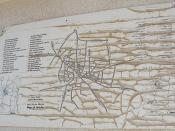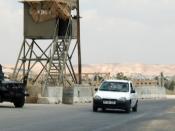By about 7000 B.C., techniques of agricultural production in the Middle
East had reached a level at which it was possible to support thousands of
people, many of whom were not engaged in agriculture, in densely populated
settlements. Two of the earliest of these settlements were at Jericho in what
is today the Israeli-occupied West Bank, and at Catal Huyuk in present-day
southern Turkey. With populations of about 2000 and from 4000 to 6000 people
respectively, Jericho and Catal Huyuk would be seen today as little more than
large villages or small towns. But in the perspective of human cultural
development they represented the first stirrings of urban life. In these and
other Middle Eastern Neolithic settlements, occupational specialization and
the formation of religious and political-military elite groups advanced
significantly. Trade became essential for the community's survival and was
carried on, perhaps by specialized merchants, with peoples at considerable
distances. Crafts such as pottery, metalworking, and jewelry making were
highly developed. At Catal Huyuk in particular, both sculpture and wall
painting were carried to a high level of sophistication.
In these earliest town centers, the key ingredients of civilization came
together. Agricultural surpluses were sufficient to support specialized
non farming producers and non farming political and religious leaders. The
interaction of these groups resulted in a burst of creativity and innovation
in a wide variety of fields. But these earliest centers were quite isolated.
They were merely tiny islands of sedentary cultivators and small numbers of
townspeople, surrounded by vast plains and woodlands. The earliest town
centers appear to have traded rather extensively but to have maintained only
intermittent and limited contacts with neighboring hunting-and-gathering
peoples. Though small in size and not highly specialized in comparison with
the cities of Sumer and other early civilizations, the first towns, settled
during this period, nonetheless played critical roles in continuing the
Neolithic transformation. The ruling elites and craft specialists of these
towns contributed in several major ways to the introduction in the 4th
millennium B.C. of critical inventions - inventions such as the wheel, the
plow, writing, and the use of bronze - that secured the future of civilized
life as the central pattern of human history.
Jericho
Proximity to the Jordan River and the deep and clear waters of an oasis
spring account for repeated human settlement at the place where the town of
Jericho was built. By 7000 B.C., over ten acres at the site were occupied by
round houses of mud and brick resting on stone foundations. Most early houses
had only a single room with mud plaster floors and a domed ceiling, but some
houses had as many as three rooms. Entry to these windowless dwellings was
provided by a single wood-framed doorway and steps down to the floor of the
main room underground. Although there is no evidence that the town was
fortified in the early stages of its growth, its expanding wealth made the
building of walls for protection from external enemies increasingly
imperative. The town was enclosed by a ditch cut into the rocky soil and a
wall reaching almost 12 feet in height. The extensive excavation required for
this construction is quite impressive because the peoples who undertook it
possessed neither picks nor shovels. The stones for the wall were dragged from
a riverbed nearly a mile away. These feats of transport and construction
suggest not only a sizable labor force but one that was well organized and
disciplined.
When Jericho was rebuilt in later centuries, the wall reached a height of
nearly 15 feet, and the fortifications included a stone tower at least 25 feet
high. The area covered by the town increased. Round houses gave way to
rectangular ones, entered through larger and more elaborately decorated wooden
doorways. Houses were built of improved bricks, were provided with plaster
hearths and stone mills for grinding grain, and were furnished with storage
baskets and straw mats. In addition, small buildings that were used as
religious shrines were found in the later stages of the city's history.
Though the economy of Jericho was based primarily upon the farming of
wheat and barley, there is considerable evidence of reliance on both hunting
and trade. Domesticated goats provided meat and milk, while gazelles and
various marsh birds were hunted for their flesh, hides, and feathers. The town
was close to large supplies of salt, sulfur, and pitch. These materials, which
were in great demand in this era, were traded for obsidian - dark, glasslike
volcanic rock - semiprecious stones from Anatolia, turquoise from the Sinai,
and cowrie shells from the Red Sea.
The ruins excavated at Jericho indicate that the city was governed by a
distinct and quite powerful ruling group, which was probably allied to the
keepers of the shrine centers. There probably were specialized artisans and a
small merchant class. In addition to the fertility figurines and animal
carvings found at many other sites, the inhabitants of Jericho sculpted
life-sized, highly naturalistic human figures and heads. These sculptures,
which may have been used in ancestor cults, give us vivid impressions of the
physical features of the people who enjoyed the wealth and security of
Jericho.
Catal Huyuk
The first community at this site in southern Turkey was founded around
7000 B.C., somewhat later than the earliest settlements at Jericho. But the
town that grew up at Catal Huyuk was a good deal more extensive than that at
Jericho and contained a larger and more diversified population. Catal Huyuk
was in fact the most advanced human center of the Neolithic period. At the
peak of its power and prosperity the city occupied 32 acres and contained as
many as 6000 people. Its rectangular buildings, which were centers of family
life and community interaction, were remarkably uniform - built of mud-dried
bricks. They had windows high in their walls and were entered from holes in
their flat roofs. These entryways also served as chimneys for the fireplaces
that the houses contained. The houses were joined together to provide
fortification for the town. Movement within the settlement was mainly across
the roofs and terraces of the houses. Since each dwelling had a substantial
storeroom, when the ladder to the roof entrance was pulled up, each became a
separate fortress within the larger complex.
The standardization of housing and construction at Catal Huyuk suggests
an even more imposing ruling group than that found at Jericho. The many
religious shrines found at the site also indicate the existence of a powerful
priesthood. The shrines were built in the same way as ordinary houses, but
they contained sanctuaries surrounded by four or five rooms related to the
ceremonies of the shrine's cult. The walls of these religious centers were
filled with paintings of bulls and carrion eaters, especially vultures,
suggesting fertility cults and rites associated with death. The statuary that
has survived indicates that the chief deity of the Catal Huyuk peoples was a
goddess, who is variously depicted as a young woman giving birth or nursing a
small child, and as an old woman accompanied by a vulture.
The obvious importance of the cult shrines and the elaborate burial
practices of the peoples of Catal Huyuk reveal the growing role of religion in
the lives of Neolithic peoples. The carefully carved sculptures associated
with the sanctuaries and the fine jewelry, mirrors, and weapons found buried
with the dead attest to the high level of material culture and artistic
proficiency achieved by these town dwellers. Excavations of the settlement
also reveal an economic base that was much broader and richer than that of
Jericho. Hunting remained a factor, but the breeding of goats, sheep, and
cattle vastly surpassed that associated with Jericho. A wide range of foods
were consumed by Catal Huyuk's inhabitants, including several grains, peas,
berries, berry wine, and vegetable oils made from nuts. Trade was extensive
both with the peoples in the surrounding hills and with places as distant as
present-day Syria and the Mediterranean region. Catal Huyuk was also a major
center of artisan production. Its flint and obsidian weapons, jewelry, and
obsidian mirrors were some of the finest produced in the Neolithic era. The
remains of the town's culture leave little doubt that its inhabitants had
achieved a civilized level of existence.
Document: Evidence Of Life In The Earliest Towns
Because writing had not yet been invented at the time that towns such as
Jericho and Catal Huyuk were settled, the remains of buildings and artifacts
dug up at these sites provide our best sources about the lives of the people
who lived there. The artifacts and the town plan are from the town of Hacilar
that was built in present-day Turkey about 1000 years after the town of Catal
Huyuk.
Online Tutorial - Urban
What are site factors?
Site factors are those considerations which are made by humans when deciding on the ideal location for a settlement. The factors outlined below are not exhaustive, but are the main 8 considerations for the siting of ancient settlements. Site factors for new settlements today, still have to take some of these into account, and may have even more to consider.
________________________________________
1 - Protection
It was especially important to protect settlements from those who wished to attack. A good vantage point to watch for this was a hill, and many castles and forts were built on hills to watch for attackers. There was a disadvantage with this site though, as climatically, these settlements were prone to wind and harsher weather.
Protection can also mean protection from the weather. See 'shelter' below for factor that deals with this.
2 - Plenty of Water
Washing, drinking and cooking all need water, and it was vital to have an adequate supply especially during the summer. Springs, wells and rivers provided supplies, but it was important to take into account the third site factor below, to prevent flooding and damage.
Nowadays, settlements have water piped to them, but it is still a consideration to be near to the mains supply or in a region that actually has adequate rainfall to sustain a supply.
3 - Not Too Much Water
It was important then and is still important to ensure that settlements are not built on areas that will flood, or are marshy (as the settlement will sink).
This isn't always possible to see, particularly if the floods only occur every few years, or there isn't a flood whilst building the settlement. Many settlements flood each year for these reasons and in fact some settlements in many poorer parts of the world are built on flood areas - this is because flooding provides fertile alluvium to agricultural land.
4 - Rivers
Rivers can be useful supplies of water in themselves, or agents of flooding. But what is important about rivers as a site factor is that they can be crossed, either by bridge or ford. A river that couldn't be crossed would have been a major problem for early settlements, particularly if they couldn't escape across a river during an attack. Rivers can now be crossed by building bridges, but these are expensive.
5 - Building Materials
Either wood or stone was needed to build early settlements, so a forest, wood or hillside with crags was needed to provide the materials. This is not so important today, as houses are built of brick and slate, which are easily provided. However, in the National Park areas of the UK, there are strict building regulations which often determine the type of stone and roofing material that should be used to build with. It would therefore be vital that these are available.
6 - Supply of Wood
Not as important today, but early settlements would need wood for fuel. It was therefore vital that the settlement was near trees.
7 - Flat Land
It is extremely difficult to build a settlement on land with a gradient (such as a hillside) and so land should be flat wherever possible. This should not be confused, as it often is, with low-lying land: the top of a high hill or plateau could be flat too.
It is possible to build a settlement now on a gradient, but it is much more time consuming and expensive. This tends to be done only where there is limited space, such as the terraced housing in the coal mining valleys of South Wales, UK.
8 - Shelter
It is important the direction that the settlement faces, and this is geographically known as aspect. In early settlements, it was important that agricultural land faced south so that the sun shone directly on the land. If land faces north in the UK, it never has the sun shining directly on it. Shelter from the weather, especially in winter was essential. Building a settlement in a valley provided a way to keep out of harsh winds.
Today, a consideration of aspect is made as a routine part of most settlement planning. The Byker Redevelopment in Newcastle was partly redesigned with geographical aspect in mind. Click here to see how this settlement used aspect.


